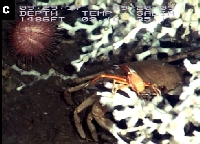DISCOVRE 2008
Cruise Log: 10/06/2008 Sea State: 3'-4' with a Light Chop
Arms, Tubes, Claws, and Spines, These are a Few of my Favorite Things
Martha Nizinski
 |
| Martha Nizinski |
Deep-water (aphotic= no sunlight) coral systems are important habitats for both vertebrates and invertebrates, and are hotspots of increased biodiversity. Our knowledge of species diversity and habitat associations continues to increase, yet the taxonomy, systematics, ecology, and species distribution of even the most conspicuous species groups remain largely unknown. These are the topics that interest me the most, particularly when it comes to squat lobsters, but I am gaining knowledge and interest in other invertebrate groups with each new collection. While out at sea we will be collecting as much data as possible on all the invertebrates we see or collect using either a Remotely Operated Vehicle (ROV) or various types of nets. The information we gather will help us gain an improved understanding of deep reef habitat usage and associations through descriptions of deep reef and off reef (nearby) fauna and related ecosystem characteristics.
 |
| The squat lobster, Eumunida picta, sits upon a deep-water crab (Chaceon spp.), while the sea urchin (Echinus tylodes) approaches from the left. - (photo credit: Open-File Report 2008-1148 & OCS Study MMS 2008-015) - click to enlarge |
Our specific objectives include: 1) provide identifications of the associated megafaunal invertebrates (> 1 cm in size) observed on and around the targeted study sites, 2) assess levels of endemism (i.e., are there any species that occur only at these deep-sea coral sites and no where else) at deep coral habitats, 3) examine patterns of species diversity and geographic distribution of the invertebrate fauna between sites and make comparisons with similar habitats in other locations, 4) assess community structure, basic ecology and population dynamics of the invertebrate fauna.
Proper identification is critical to assessing the distinctiveness of the fauna and estimating biodiversity. Without deep-sea expeditions like this one where we are able to observe the animals first hand and hopefully collect some individuals for further examination, we must rely on specimens housed in natural history museums and collections. Many deep-sea invertebrate species, however, are underrepresented in museum collections, and available specimens are often old, perhaps collected in the early 1800s to mid 1900s, and fragile with vague locality information. Thus, museum collections provide limited insight into natural color patterns, intraspecific (within species) variation and habitat associations. Targeted collections made with ROV are invaluable to our basic understanding of these species. Also, the potential for discovery of species new to science at the Gulf of Mexico (GOM) deep coral sites is extremely high. To date, at least three new species of decapod crustaceans have been identified from samples taken at GOM
Lophelia sites. Additionally, several other invertebrate species (e.g., decapod crustaceans, hydroids, echinoderms) from this region may prove to be new also.
 |
| The giant isopod, Bathynomus gigantea, are commonly observed in these deep coral habitats. - (photo credit: M. Nizinski) - click to enlarge |
Habitat association data and basic biology are lacking in the GOM from all areas. In particular, no study has addressed the interconnectedness and relationships between meio-, macro-, and megafauna, or between invertebrate and vertebrate assemblages and the coral habitat.
This work is fundamental to all other aspects of our research initiative and will complement and expand previous studies of the invertebrate fauna found on and around deep-coral communities from the upper slope. We have to know who is out there, where they are found, what they are doing, and what they are eating, before we can make any conclusions about the structure and function of these deep-coral habitats. The data collected during this study, in combination with our extensive data set, will provide the information necessary to compare local (among sites), regional (Atlantic versus Gulf of Mexico), and habitat (
L. pertusa vs other hardgrounds vs non-reef) patterns in species diversity, biodiversity with depth and latitude, biogeography and community structure of the associated invertebrate (macro- and meio-) and vertebrate fauna.